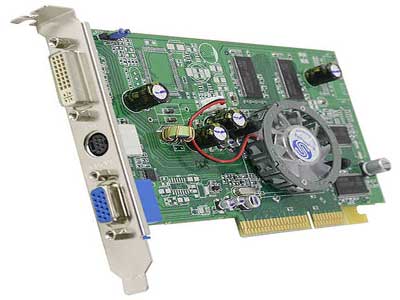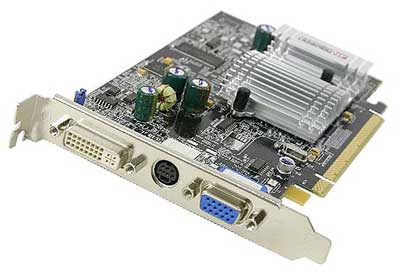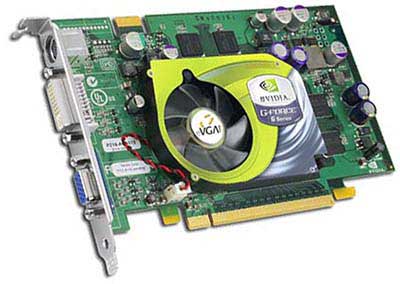Buyer's Guide - Mid-Range, October 2004
by Jarred Walton on October 21, 2004 11:00 AM EST- Posted in
- Guides
Graphics Recommendations
The only typical applications that actually require a decent graphics card are games, but depending on how you plan to use the system, adding a little more power to the graphics subsystem may not be a bad idea. We listed an integrated graphics motherboard as an option for a base Intel system, and that will save you a little money. For the AGP models, a basic Radeon or GeForce will get you by. One of the advantages of purchasing an add-in card is that even the basic models support two displays. This is definitely an advantage for software development and content creation work, where having dozens of windows open at a time is par for the course.Those who are interested in more serious work, like 3D modeling and rendering, might want to look into professional 3D graphics cards, although moderate consumer graphics cards will be sufficient for less serious work. Those looking for an all-around system will also want more than just a basic graphics card. With that said, let's get on to the recommendations.

AGP Recommendation: Sapphire Radeon 9600 Pro 128MB
Price: $108 Shipped (OEM)
At just over $100, the 9600 Pro offers tremendous value. Casual gamers will have more than enough performance for most games, while those interested in content creation or software development get the proven reliability and performance of ATI's drivers. TV Out is also included, for those who might be looking for a Home Theater PC. While it might seem like overkill for anyone who doesn't use any form of 3D graphics, it is hard to recommend anything less than a DirectX 9.0 capable graphics card for any system costing over $1000. Remember that Windows Longhorn - assuming it ships anytime soon - is going to require DX9 support as the bare minimum in order to run. The one option that isn't available for this price is dual DVI output, so those looking at running dual LCD displays might want to find a model that has two DVI ports. While the performance is lower, HIS makes a dual DVI 9600 card that might interest some of you. Downgrading to a stock 9600 or even a 9600SE is also an option if you are sure you don't need the added performance of the 9600 Pro.

Basic PCIe Recommendation: Sapphire Radeon X300 128MB
Price: $85 Shipped (OEM)
PCI Express graphics cards tend to carry a slight price premium, and the X300 is actually comparable to the 9600. The X600 Pro matches the clock speeds of the 9600 Pro, but it costs a little more. For basic computing tasks other than gaming, they will both perform acceptably, so here we go with the slightly cheaper X300. Unfortunately - or fortunately if you're looking for an excuse to upgrade - those looking for dual DVI ports will need to buy a 6600GT card for the time being; specifically, the XFX is one card that includes that option. There are no other PCI Express graphics cards with two DVI ports other than the ultra-expensive X800 XT and Quadro FX1300, which really aren't an option for this price range.

PCIe Alternative: eVGA 6600GT 128MB
Price: $207 Shipped (Retail)
Here, PCI Express has a slight advantage in the price/performance category. The 6600GT includes 8 pixel pipelines, and with a core clock of 500 MHz, it outperforms any AGP card in the same price bracket. ATI's X700 Pro is also available at about the same price and it is similar in features, but comes with 256 MB of GDDR3. The X700XT with 128 MB of RAM and faster clock speeds is also due to show up in retail any time now, but we have not been able to find it there yet. This is really a gaming option, but we would feel remiss if we didn't at least mention it, as the 6600GT is one of the best price/performance graphics cards currently available.
For AGP systems that will be used for moderate amounts of gaming, the only comparable card right now is the 9800 Pro. It's a bit slower in most games and lacks support for SM3.0 but it performs acceptably. The GeForce 6800 is also an option that is slightly faster than the 6600GT and costs a bit more.










54 Comments
View All Comments
Tides - Thursday, October 21, 2004 - link
when i think mid-range i do find it hard to look below 9800/6600.PrinceGaz - Thursday, October 21, 2004 - link
This article wasn't focussing on a system where gaming will be a major consideration. The reason for recommending a 9600 Pro (or X300) for discrete graphics is that DX9 hardware will be required for Longhorn when it arrives. A 9800 Pro would be overkill for that.neogodless - Thursday, October 21, 2004 - link
Okay, the price on the 19" monitor IS definitely a typo though! Also, personally I'd spend a touch $100 more for a 9800 Pro (over the 9600 Pro) if at all possible because I think a ~10% increase in overall cost for a much better gaming experience is worth it...neogodless - Thursday, October 21, 2004 - link
n/m... I see it's the 939 pin part... going on the assumption that dual channel increases that chips performance enough for a 200+ higher rating...neogodless - Thursday, October 21, 2004 - link
The Athlon 64 3200+ (90nm) is a 2.0Ghz 512kb cache part? Is that a typo? Should that read Athlon 64 3000+ ?tappertrainman - Thursday, October 21, 2004 - link
Great Job! I definitely like these style "guides" rather than the CPU motherboard guides by themselves. Also, I think a great idea would be to start an "upgrade" guide similar to these. You could have an entry-level mid-level and high-end upgrade guide each month? Thanks for the hard work.gimper48 - Thursday, October 21, 2004 - link
Very good. I am impressed. However, are we going to see benchmarks in these anytime soon?southernpac - Thursday, October 21, 2004 - link
I am very inclined to take your recommendation and use a Raid 1 (mirrow) back up strategy. Do I incur a performance "price" for making the constant back-up? If so, will it be significant enough for a simulations gamer to really notice the difference (I'll be using a higher-end system)?Kong Basse - Thursday, October 21, 2004 - link
Thank you for another good article.The article was absolutly not too long, only proclaim that I have is: The 9600 id getting a little old by now, but then again, it still isnt too bad for gaming, even though it hardly runs Doom3 and HL2.
PrinceGaz - Thursday, October 21, 2004 - link
I've just finished reading it and amazingly, I can't fault any of your recommendations!I'd say you've covered pretty much everything you set out to starting with solid recommendations for a base system, and providing excellent reasons for why someone might want to choose one of the alternatives suggested.
Probably the best system guide to date. Well done.